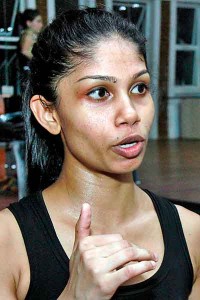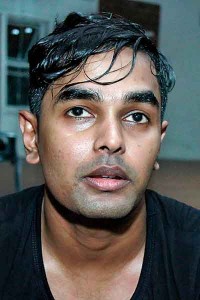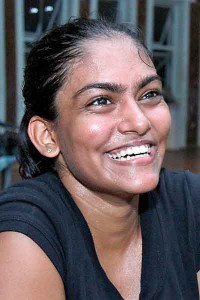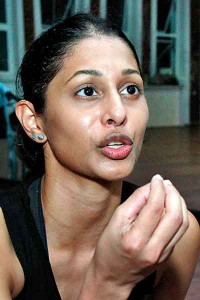Arts
Moving to the rhythms of body and mind
Dramatic and ominous-sounding music that probably belongs on the soundtrack of a dystopian movie plays and the dancers, all in black, move as if the music is possessing them and flowing through their bodies. Ten minutes go by. We see the exertion on their faces, but there is no break. We are enthralled, our senses overloaded and for a moment we forget we are here to interview the cast of “Seven: the seeker, the thinker”.

Pushing the boundaries of dance: The cast at rehearsals. Pix by Indika Handuwala
A contemporary dance performance by Mesh Academy of Dance, the show on November 10, 11 and 12, is a collaboration with the Department of Drama, Oriental Ballet and Contemporary Dance of the University of Visual and Performance Arts. Choreographed by founder and artistic director of the Mesh Academy of Dance Umeshi Rajeendra, ‘Seven’ explores the concept of the number through three performance items.
Unlike the more structured dance forms like ballet, Kandyan and Latin dance, from which backgrounds most of her students are from, contemporary dance requires its performers to dig deep and express emotions that come from within. “You invest yourself in it. It’s a very personal journey for the dancer,” explains Aby Brochard of the Mesh Academy. “There’s a lot of self-exploration, about myself and my body,” says Roshni Gunaratne alluding to the fact that it demands more from the body and the mind of the dancer than the more formal dance forms do.
“It’s more than just steps to music. It pushes you to find a way to connect,” says Sandarangi Perera, explaining that it teaches you to empathize, especially if you haven’t personally been in a certain situation or felt a particular emotion in that way.
Romesh Fernando, likens contemporary dance to theatre for its expressiveness, but notes that unlike in theatre they are confined to movement and expressions alone and so must put in more effort to convey their concepts and narratives to the audience. “You have to project it to the audience, and must be crystal clear about it.”
For a genre that is all about freedom in movement and expression, it also surprisingly requires a lot of technique. “You work a different set of muscles for it,” says Romesh, comparing it to Latin and Kandyan dancing. Even when it comes to breathing, how you move with your breathing is focused on, explains Rangi Fernando, saying this was something she never thought about in all her years of dancing. “There’s an idea that as an adult you don’t have to learn, but coming to rehearsals you see that there is a long path to go and (a lot) to learn,” says Aby.
The performance entails great deal of physical exertion with some items requiring 30 minutes of constant movement. “It’s intense, but a good kind of tired,” says Roshni, adding that she loves the challenge and the physicality of it all. That intensity has a very cathartic effect says Niren Ranasinghe who found the the genre allowed him to express himself in a way which he couldn’t do with theatre and other forms of dance.
Each dancer has their own view of the concept of the number seven, and the audience too is free to give their own interpretations to it. “You don’t spoonfeed them,” says Niren. After the feedback they received from previous shows, the dancers are eager to see how audiences will react.

Director and choreographer: Umeshi Rajeendra
The youngest dancer Onara De Silva, 17, believes the ‘think out-of the-box’ abstract nature of the show’s concept is a good addition to Sri Lanka’s dance scene, instead of the stereotypical performances so often seen on stage. Onara, a student at Ladies’ College, dreams of becoming a professional dancer and says that contemporary dance has really helped her grow as a dancer.
Performing at ‘7’ are Annabelle (Aby) Brochard, Roshni Gunaratne, Sandarangi Perera, Romesh Fernando, Niren Ranasinghe, Rangi Fernando, Onara De Silva, Dilukshi Wickremasinghe, Pathum Dharmaratne, Daham Anurada, Shashika Madushan, Bhagya Laksha, and Indika Lakmal. The show will also feature original music composed by the talented Natasha Senanayake.
‘Seven: the seeker, the thinker’ will be on November 10, 11, and 12 at the University of Visual and Performing Arts Auditorium at 7.30 p.m , with an additional performance at 2.30 p.m. on November 11. The University of Visual and Performing Arts is located at No. 21 Albert Crescent, Colombo 7. Tickets priced at Rs. 1000, 1500, 2000 and 2500, can be purchased online at www.daraz.lk or from their head office at No. 51 Gregory’s Road, Colombo 7.

Niren Ranasinghe

Sandarangi Perera

Romesh Fernando

Onara De Silva

Roshni Gunaratne

Rangi Fernando

Aby Brochard

